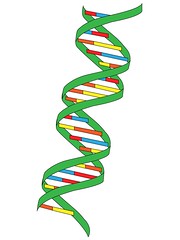| 9831375650 | DNA Replication | process by which DNA molecule is copied; DNA synthesis (S stage of interphase) |  | 0 |
| 9831375651 | Transformation | a change in genotype and phenotype due to the assimilation of external DNA by bacteria |  | 1 |
| 9831375652 | Bacteriophages | Viruses that infect bacteria Bacteria eaters |  | 2 |
| 9831375653 | Virus | infects a cell and takes over the cell's metabolic machinery |  | 3 |
| 9831375654 | Hershey and Chase | Concluded that viral DNA entered bacterial host cells, but viral proteins did not, so DNA fis the genetic material |  | 4 |
| 9831375655 | Chargaff's Law | the base compostion of DNA varies between species and for each species, the percentages of A and T bases are roughly equal to the percentages of the G and C bases | 5 | |
| 9831375656 | Rosalind Franklin | X-ray crystallographer that discovered the double helix of DNA |  | 6 |
| 9831375657 | Watson and Crick | discovered the structural double helix model of DNA | 7 | |
| 9831375658 | Double helix | two twisted strands |  | 8 |
| 9831375659 | Antiparallel | subunits run in opposite directions |  | 9 |
| 9831375660 | Nitrogenous bases of Dna | A, T, C, G |  | 10 |
| 9831375661 | Purines | A and G Nitrogenous bases with two organic rings |  | 11 |
| 9831375662 | Pyrimidines | C and T Nitrogenous base with a single organic ring |  | 12 |
| 9831375663 | Semiconservative Model | the two strands of the parental molecule separate and each functions as a template for synthesis of a new complementary strand- most common |  | 13 |
| 9831375664 | Origins of Replication | short stretches of DNA having a specific sequence of nucleotides |  | 14 |
| 9831375665 | Replication Fork | a Y shaped region where the parental strands of DNA are being unwound |  | 15 |
| 9831375666 | Helicases | enzymes that untwist the double helix at the replication forks, separating the two parental strands and make them available as template strands |  | 16 |
| 9831375667 | Topoisomerase | The untwisting of double helix causes tighter twisting and strain ahead of replication fork Relieve this strain by breaking swiveling, and rejoining DNA strands |  | 17 |
| 9831375668 | Leading strand | Strand that continuously adds nucleotides to the new complementary strand as the fork progresses |  | 18 |
| 9831375669 | Lagging Strand | The strand that DNA polymerase works away from the replication fork; Synthesized discontinuosly as a series of segments |  | 19 |
| 9831375670 | Okazaki fragments | Series of segments that are 1000-2000 nucleotides long |  | 20 |
| 9831375671 | DNA Ligase | joins the sugar phosphate backbones of all the Okazaki fragments into a continuous DNA strand |  | 21 |
| 9831375672 | DNA polymerase | Synthesizes new DNA strands by adding nucleotides to a pre-existing DNA strand |  | 22 |
| 9831375673 | Mismatch repair | Other enzymes remove and replace incorrectly paired nucleotides that have resulted from replication errors | 23 | |
| 9831375674 | Nuclease | DNA cutting enzyme that cuts out the damaged parts of the strand and fills the space with nucleotides using the undamaged strand as a template |  | 24 |
| 9831375675 | Nucleotide excision repair | DNA repair system where teams of enzymes detect and repair the DNA, the nuclease cuts out the damaged DNA and removes it, fills in the missing nucleotides and the DNA ligase seals the free end of the new DNA to the old DNA making the strand complete |  | 25 |
| 9831375676 | Telomeres | Special nucleotide sequences at the ends of chromosomes TTAGGG is repeated between 100-1000 times Prevent the staggered ends of daughter molecule from activitating cell's system for monitoring DNA damage |  | 26 |
| 9831375677 | Histones | Proteins that are responsible for the first level of DNA packing in chromatin |  | 27 |
| 9831375678 | Nucleosome | the basic unit of DNA packing |  | 28 |
| 9831375679 | Chromatin | complex of DNA and protein |  | 29 |
| 9831375680 | plasmid | small circular DNA strand in the cytoplasm of a bacterium |  | 30 |
| 9831375681 | Avery, McCarty, McLeod experiment | Protein- and RNA-degrading enzymes had little effect on transformation, but enzymes that degrade DNA eliminated the transforming activity. |  | 31 |
| 9831375683 | complementary |  | 32 | |
| 9831375682 | retrovirus | RNA virus; uses reverse transcriptase enzyme to produce DNA from its RNA genome | 33 | |
| 9831375684 | nucleotide |  | 34 |
AP BIology DNA Replication Flashcards
Primary tabs
Need Help?
We hope your visit has been a productive one. If you're having any problems, or would like to give some feedback, we'd love to hear from you.
For general help, questions, and suggestions, try our dedicated support forums.
If you need to contact the Course-Notes.Org web experience team, please use our contact form.
Need Notes?
While we strive to provide the most comprehensive notes for as many high school textbooks as possible, there are certainly going to be some that we miss. Drop us a note and let us know which textbooks you need. Be sure to include which edition of the textbook you are using! If we see enough demand, we'll do whatever we can to get those notes up on the site for you!

